Analysis of Prefabrication in the Australian Construction Industry
VerifiedAdded on 2020/05/28
|14
|3421
|219
Report
AI Summary
This report, titled "Usefulness of Prefabrication in the Modern Australian Construction Industry," investigates the application, benefits, and drawbacks of prefabrication in the Australian construction sector. The research aims to analyze prefabrication, also known as offsite construction, and its impact on cost-effectiveness, time efficiency, and labor savings. The report explores the rationale behind the reluctance to adopt prefabrication in developing countries and presents evidence supporting its advantages over traditional construction methods. The research plan includes a qualitative approach using interviews and questionnaires to gather data, followed by an analysis of the findings. The study employs abductive reasoning to understand the varied perceptions of prefabrication. The report also discusses various research strategies, including ethnography, action research, and grounded theory, and details the data collection and analysis methods. The aim is to offer a comprehensive understanding of prefabrication's role and potential in the modern construction industry.

Research Methodology 1
RESEARCH METHODOLOGY
By Name
Course
Instructor
Institution
Location
Date
RESEARCH METHODOLOGY
By Name
Course
Instructor
Institution
Location
Date
Paraphrase This Document
Need a fresh take? Get an instant paraphrase of this document with our AI Paraphraser
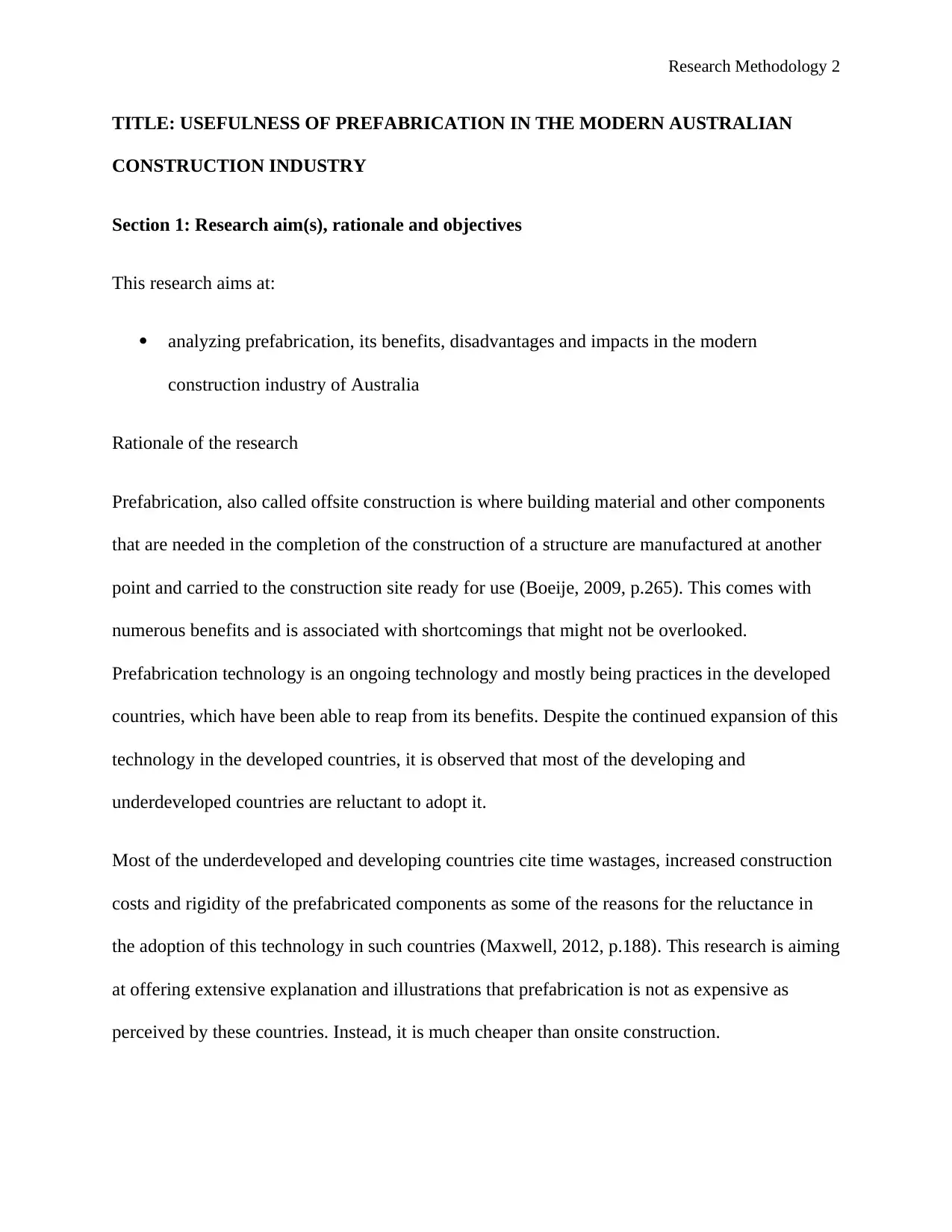
Research Methodology 2
TITLE: USEFULNESS OF PREFABRICATION IN THE MODERN AUSTRALIAN
CONSTRUCTION INDUSTRY
Section 1: Research aim(s), rationale and objectives
This research aims at:
analyzing prefabrication, its benefits, disadvantages and impacts in the modern
construction industry of Australia
Rationale of the research
Prefabrication, also called offsite construction is where building material and other components
that are needed in the completion of the construction of a structure are manufactured at another
point and carried to the construction site ready for use (Boeije, 2009, p.265). This comes with
numerous benefits and is associated with shortcomings that might not be overlooked.
Prefabrication technology is an ongoing technology and mostly being practices in the developed
countries, which have been able to reap from its benefits. Despite the continued expansion of this
technology in the developed countries, it is observed that most of the developing and
underdeveloped countries are reluctant to adopt it.
Most of the underdeveloped and developing countries cite time wastages, increased construction
costs and rigidity of the prefabricated components as some of the reasons for the reluctance in
the adoption of this technology in such countries (Maxwell, 2012, p.188). This research is aiming
at offering extensive explanation and illustrations that prefabrication is not as expensive as
perceived by these countries. Instead, it is much cheaper than onsite construction.
TITLE: USEFULNESS OF PREFABRICATION IN THE MODERN AUSTRALIAN
CONSTRUCTION INDUSTRY
Section 1: Research aim(s), rationale and objectives
This research aims at:
analyzing prefabrication, its benefits, disadvantages and impacts in the modern
construction industry of Australia
Rationale of the research
Prefabrication, also called offsite construction is where building material and other components
that are needed in the completion of the construction of a structure are manufactured at another
point and carried to the construction site ready for use (Boeije, 2009, p.265). This comes with
numerous benefits and is associated with shortcomings that might not be overlooked.
Prefabrication technology is an ongoing technology and mostly being practices in the developed
countries, which have been able to reap from its benefits. Despite the continued expansion of this
technology in the developed countries, it is observed that most of the developing and
underdeveloped countries are reluctant to adopt it.
Most of the underdeveloped and developing countries cite time wastages, increased construction
costs and rigidity of the prefabricated components as some of the reasons for the reluctance in
the adoption of this technology in such countries (Maxwell, 2012, p.188). This research is aiming
at offering extensive explanation and illustrations that prefabrication is not as expensive as
perceived by these countries. Instead, it is much cheaper than onsite construction.
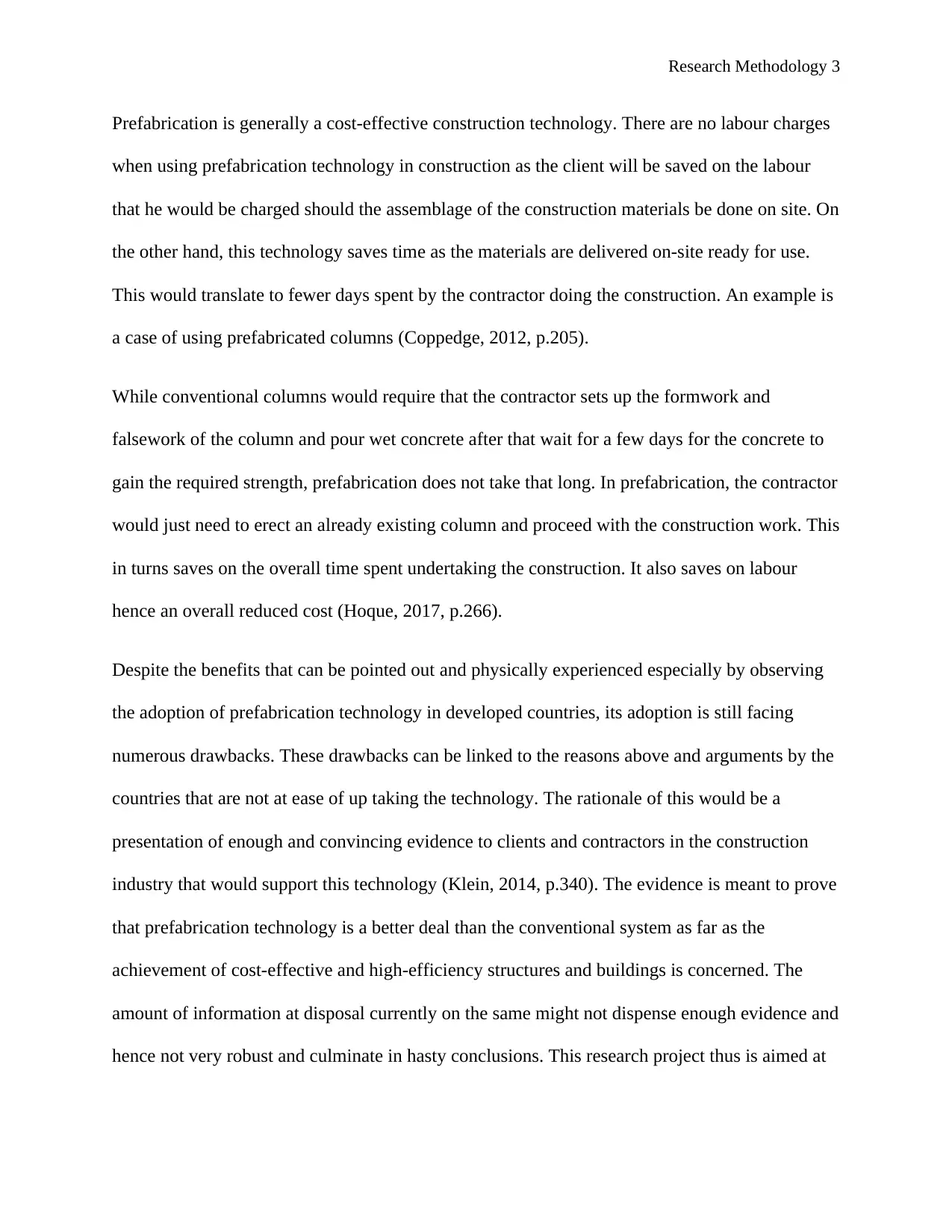
Research Methodology 3
Prefabrication is generally a cost-effective construction technology. There are no labour charges
when using prefabrication technology in construction as the client will be saved on the labour
that he would be charged should the assemblage of the construction materials be done on site. On
the other hand, this technology saves time as the materials are delivered on-site ready for use.
This would translate to fewer days spent by the contractor doing the construction. An example is
a case of using prefabricated columns (Coppedge, 2012, p.205).
While conventional columns would require that the contractor sets up the formwork and
falsework of the column and pour wet concrete after that wait for a few days for the concrete to
gain the required strength, prefabrication does not take that long. In prefabrication, the contractor
would just need to erect an already existing column and proceed with the construction work. This
in turns saves on the overall time spent undertaking the construction. It also saves on labour
hence an overall reduced cost (Hoque, 2017, p.266).
Despite the benefits that can be pointed out and physically experienced especially by observing
the adoption of prefabrication technology in developed countries, its adoption is still facing
numerous drawbacks. These drawbacks can be linked to the reasons above and arguments by the
countries that are not at ease of up taking the technology. The rationale of this would be a
presentation of enough and convincing evidence to clients and contractors in the construction
industry that would support this technology (Klein, 2014, p.340). The evidence is meant to prove
that prefabrication technology is a better deal than the conventional system as far as the
achievement of cost-effective and high-efficiency structures and buildings is concerned. The
amount of information at disposal currently on the same might not dispense enough evidence and
hence not very robust and culminate in hasty conclusions. This research project thus is aimed at
Prefabrication is generally a cost-effective construction technology. There are no labour charges
when using prefabrication technology in construction as the client will be saved on the labour
that he would be charged should the assemblage of the construction materials be done on site. On
the other hand, this technology saves time as the materials are delivered on-site ready for use.
This would translate to fewer days spent by the contractor doing the construction. An example is
a case of using prefabricated columns (Coppedge, 2012, p.205).
While conventional columns would require that the contractor sets up the formwork and
falsework of the column and pour wet concrete after that wait for a few days for the concrete to
gain the required strength, prefabrication does not take that long. In prefabrication, the contractor
would just need to erect an already existing column and proceed with the construction work. This
in turns saves on the overall time spent undertaking the construction. It also saves on labour
hence an overall reduced cost (Hoque, 2017, p.266).
Despite the benefits that can be pointed out and physically experienced especially by observing
the adoption of prefabrication technology in developed countries, its adoption is still facing
numerous drawbacks. These drawbacks can be linked to the reasons above and arguments by the
countries that are not at ease of up taking the technology. The rationale of this would be a
presentation of enough and convincing evidence to clients and contractors in the construction
industry that would support this technology (Klein, 2014, p.340). The evidence is meant to prove
that prefabrication technology is a better deal than the conventional system as far as the
achievement of cost-effective and high-efficiency structures and buildings is concerned. The
amount of information at disposal currently on the same might not dispense enough evidence and
hence not very robust and culminate in hasty conclusions. This research project thus is aimed at
⊘ This is a preview!⊘
Do you want full access?
Subscribe today to unlock all pages.

Trusted by 1+ million students worldwide
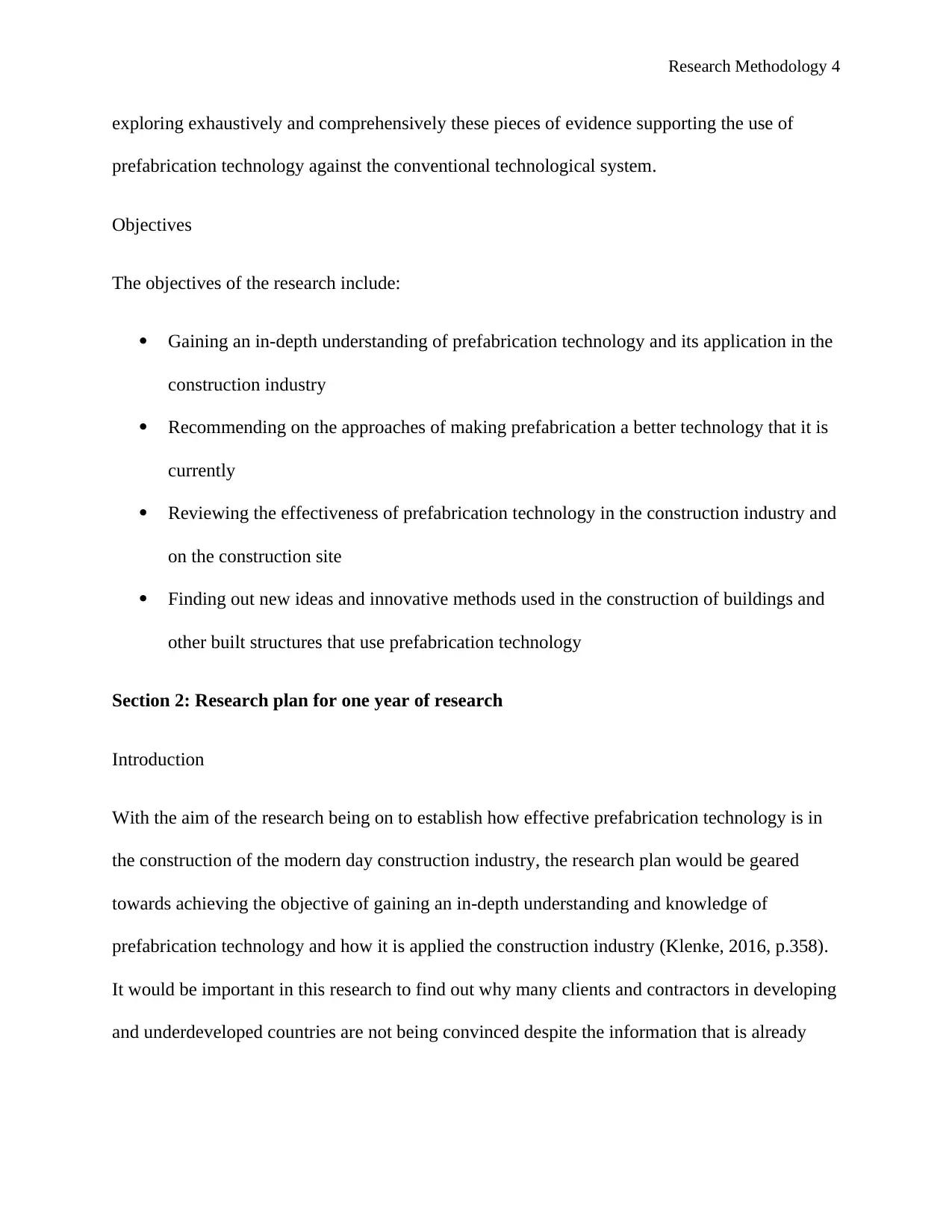
Research Methodology 4
exploring exhaustively and comprehensively these pieces of evidence supporting the use of
prefabrication technology against the conventional technological system.
Objectives
The objectives of the research include:
Gaining an in-depth understanding of prefabrication technology and its application in the
construction industry
Recommending on the approaches of making prefabrication a better technology that it is
currently
Reviewing the effectiveness of prefabrication technology in the construction industry and
on the construction site
Finding out new ideas and innovative methods used in the construction of buildings and
other built structures that use prefabrication technology
Section 2: Research plan for one year of research
Introduction
With the aim of the research being on to establish how effective prefabrication technology is in
the construction of the modern day construction industry, the research plan would be geared
towards achieving the objective of gaining an in-depth understanding and knowledge of
prefabrication technology and how it is applied the construction industry (Klenke, 2016, p.358).
It would be important in this research to find out why many clients and contractors in developing
and underdeveloped countries are not being convinced despite the information that is already
exploring exhaustively and comprehensively these pieces of evidence supporting the use of
prefabrication technology against the conventional technological system.
Objectives
The objectives of the research include:
Gaining an in-depth understanding of prefabrication technology and its application in the
construction industry
Recommending on the approaches of making prefabrication a better technology that it is
currently
Reviewing the effectiveness of prefabrication technology in the construction industry and
on the construction site
Finding out new ideas and innovative methods used in the construction of buildings and
other built structures that use prefabrication technology
Section 2: Research plan for one year of research
Introduction
With the aim of the research being on to establish how effective prefabrication technology is in
the construction of the modern day construction industry, the research plan would be geared
towards achieving the objective of gaining an in-depth understanding and knowledge of
prefabrication technology and how it is applied the construction industry (Klenke, 2016, p.358).
It would be important in this research to find out why many clients and contractors in developing
and underdeveloped countries are not being convinced despite the information that is already
Paraphrase This Document
Need a fresh take? Get an instant paraphrase of this document with our AI Paraphraser
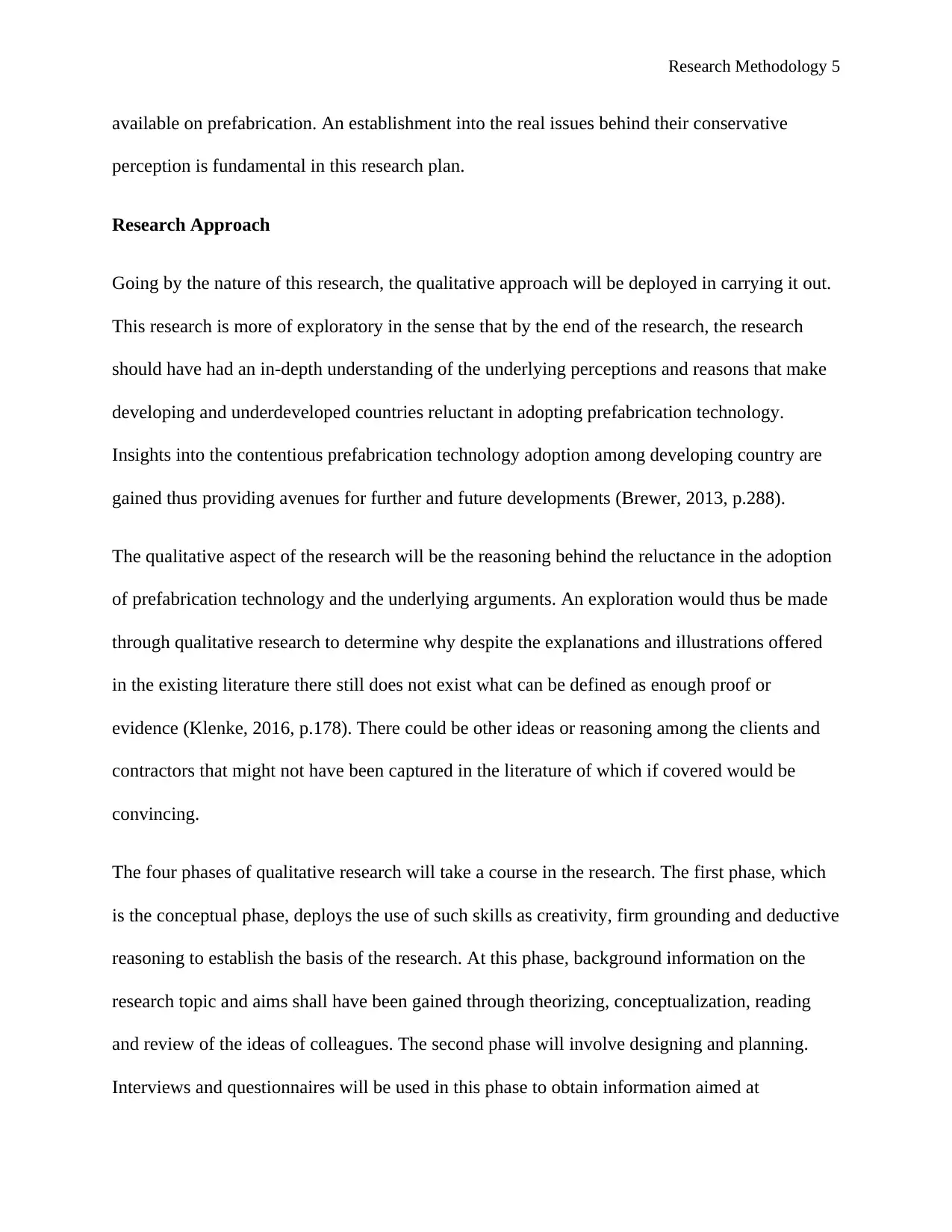
Research Methodology 5
available on prefabrication. An establishment into the real issues behind their conservative
perception is fundamental in this research plan.
Research Approach
Going by the nature of this research, the qualitative approach will be deployed in carrying it out.
This research is more of exploratory in the sense that by the end of the research, the research
should have had an in-depth understanding of the underlying perceptions and reasons that make
developing and underdeveloped countries reluctant in adopting prefabrication technology.
Insights into the contentious prefabrication technology adoption among developing country are
gained thus providing avenues for further and future developments (Brewer, 2013, p.288).
The qualitative aspect of the research will be the reasoning behind the reluctance in the adoption
of prefabrication technology and the underlying arguments. An exploration would thus be made
through qualitative research to determine why despite the explanations and illustrations offered
in the existing literature there still does not exist what can be defined as enough proof or
evidence (Klenke, 2016, p.178). There could be other ideas or reasoning among the clients and
contractors that might not have been captured in the literature of which if covered would be
convincing.
The four phases of qualitative research will take a course in the research. The first phase, which
is the conceptual phase, deploys the use of such skills as creativity, firm grounding and deductive
reasoning to establish the basis of the research. At this phase, background information on the
research topic and aims shall have been gained through theorizing, conceptualization, reading
and review of the ideas of colleagues. The second phase will involve designing and planning.
Interviews and questionnaires will be used in this phase to obtain information aimed at
available on prefabrication. An establishment into the real issues behind their conservative
perception is fundamental in this research plan.
Research Approach
Going by the nature of this research, the qualitative approach will be deployed in carrying it out.
This research is more of exploratory in the sense that by the end of the research, the research
should have had an in-depth understanding of the underlying perceptions and reasons that make
developing and underdeveloped countries reluctant in adopting prefabrication technology.
Insights into the contentious prefabrication technology adoption among developing country are
gained thus providing avenues for further and future developments (Brewer, 2013, p.288).
The qualitative aspect of the research will be the reasoning behind the reluctance in the adoption
of prefabrication technology and the underlying arguments. An exploration would thus be made
through qualitative research to determine why despite the explanations and illustrations offered
in the existing literature there still does not exist what can be defined as enough proof or
evidence (Klenke, 2016, p.178). There could be other ideas or reasoning among the clients and
contractors that might not have been captured in the literature of which if covered would be
convincing.
The four phases of qualitative research will take a course in the research. The first phase, which
is the conceptual phase, deploys the use of such skills as creativity, firm grounding and deductive
reasoning to establish the basis of the research. At this phase, background information on the
research topic and aims shall have been gained through theorizing, conceptualization, reading
and review of the ideas of colleagues. The second phase will involve designing and planning.
Interviews and questionnaires will be used in this phase to obtain information aimed at
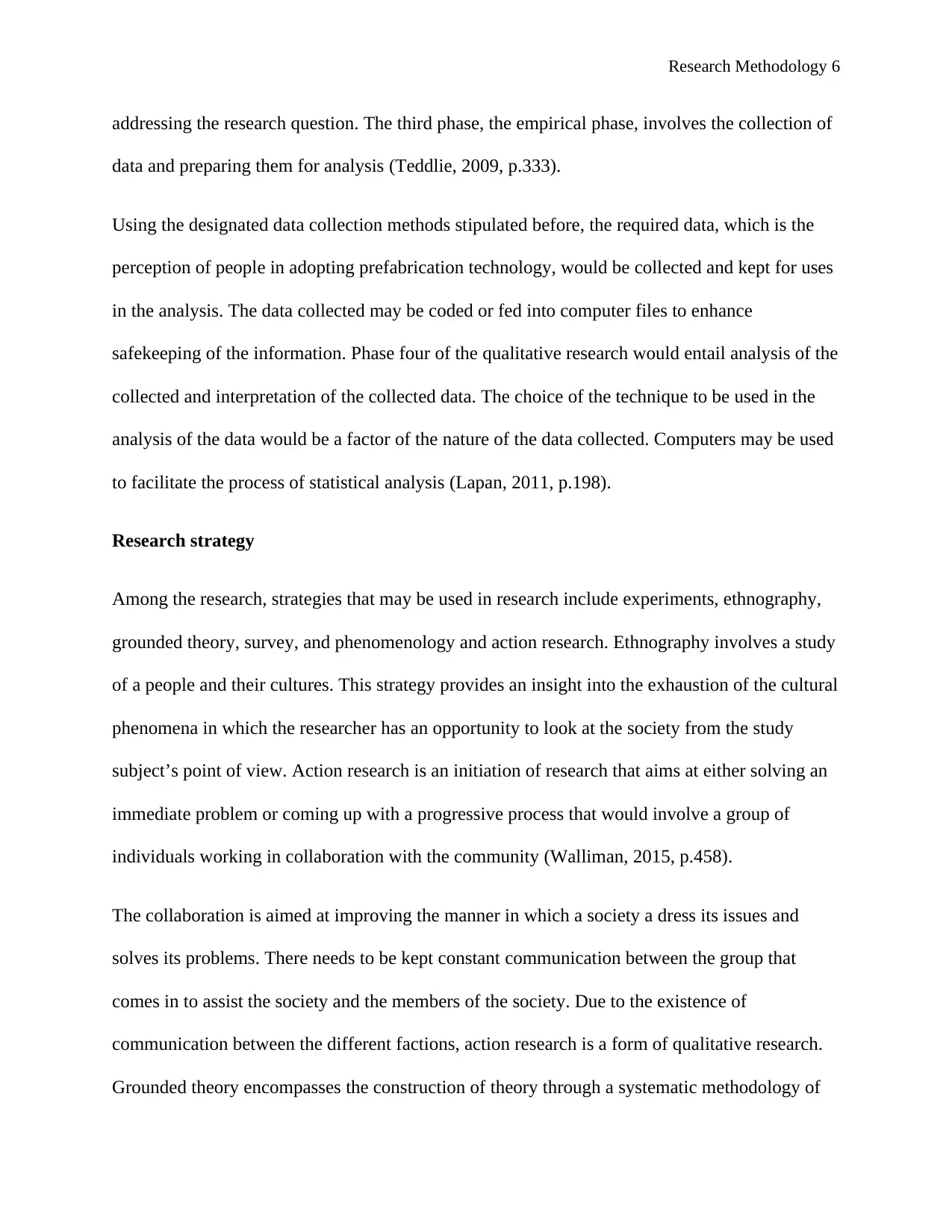
Research Methodology 6
addressing the research question. The third phase, the empirical phase, involves the collection of
data and preparing them for analysis (Teddlie, 2009, p.333).
Using the designated data collection methods stipulated before, the required data, which is the
perception of people in adopting prefabrication technology, would be collected and kept for uses
in the analysis. The data collected may be coded or fed into computer files to enhance
safekeeping of the information. Phase four of the qualitative research would entail analysis of the
collected and interpretation of the collected data. The choice of the technique to be used in the
analysis of the data would be a factor of the nature of the data collected. Computers may be used
to facilitate the process of statistical analysis (Lapan, 2011, p.198).
Research strategy
Among the research, strategies that may be used in research include experiments, ethnography,
grounded theory, survey, and phenomenology and action research. Ethnography involves a study
of a people and their cultures. This strategy provides an insight into the exhaustion of the cultural
phenomena in which the researcher has an opportunity to look at the society from the study
subject’s point of view. Action research is an initiation of research that aims at either solving an
immediate problem or coming up with a progressive process that would involve a group of
individuals working in collaboration with the community (Walliman, 2015, p.458).
The collaboration is aimed at improving the manner in which a society a dress its issues and
solves its problems. There needs to be kept constant communication between the group that
comes in to assist the society and the members of the society. Due to the existence of
communication between the different factions, action research is a form of qualitative research.
Grounded theory encompasses the construction of theory through a systematic methodology of
addressing the research question. The third phase, the empirical phase, involves the collection of
data and preparing them for analysis (Teddlie, 2009, p.333).
Using the designated data collection methods stipulated before, the required data, which is the
perception of people in adopting prefabrication technology, would be collected and kept for uses
in the analysis. The data collected may be coded or fed into computer files to enhance
safekeeping of the information. Phase four of the qualitative research would entail analysis of the
collected and interpretation of the collected data. The choice of the technique to be used in the
analysis of the data would be a factor of the nature of the data collected. Computers may be used
to facilitate the process of statistical analysis (Lapan, 2011, p.198).
Research strategy
Among the research, strategies that may be used in research include experiments, ethnography,
grounded theory, survey, and phenomenology and action research. Ethnography involves a study
of a people and their cultures. This strategy provides an insight into the exhaustion of the cultural
phenomena in which the researcher has an opportunity to look at the society from the study
subject’s point of view. Action research is an initiation of research that aims at either solving an
immediate problem or coming up with a progressive process that would involve a group of
individuals working in collaboration with the community (Walliman, 2015, p.458).
The collaboration is aimed at improving the manner in which a society a dress its issues and
solves its problems. There needs to be kept constant communication between the group that
comes in to assist the society and the members of the society. Due to the existence of
communication between the different factions, action research is a form of qualitative research.
Grounded theory encompasses the construction of theory through a systematic methodology of
⊘ This is a preview!⊘
Do you want full access?
Subscribe today to unlock all pages.

Trusted by 1+ million students worldwide
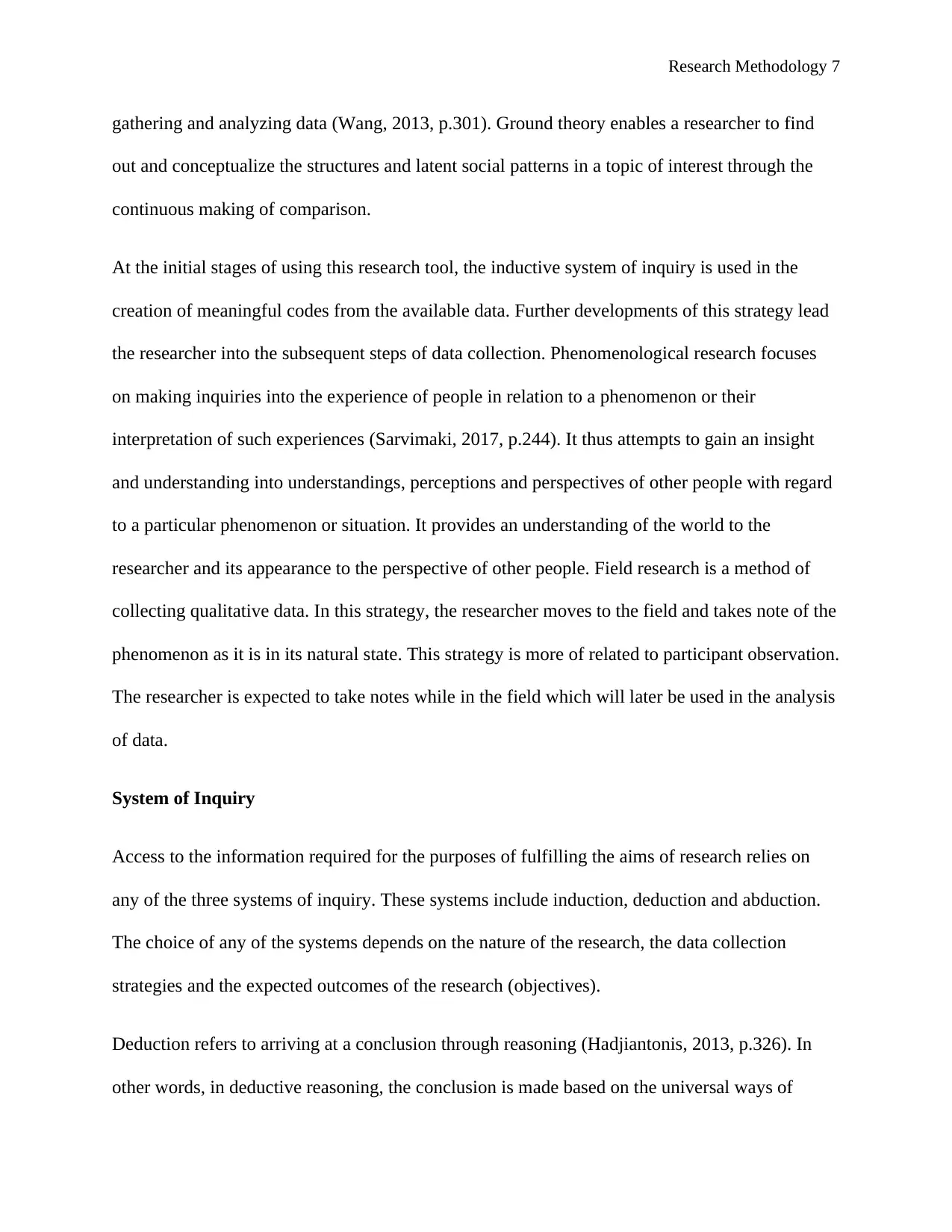
Research Methodology 7
gathering and analyzing data (Wang, 2013, p.301). Ground theory enables a researcher to find
out and conceptualize the structures and latent social patterns in a topic of interest through the
continuous making of comparison.
At the initial stages of using this research tool, the inductive system of inquiry is used in the
creation of meaningful codes from the available data. Further developments of this strategy lead
the researcher into the subsequent steps of data collection. Phenomenological research focuses
on making inquiries into the experience of people in relation to a phenomenon or their
interpretation of such experiences (Sarvimaki, 2017, p.244). It thus attempts to gain an insight
and understanding into understandings, perceptions and perspectives of other people with regard
to a particular phenomenon or situation. It provides an understanding of the world to the
researcher and its appearance to the perspective of other people. Field research is a method of
collecting qualitative data. In this strategy, the researcher moves to the field and takes note of the
phenomenon as it is in its natural state. This strategy is more of related to participant observation.
The researcher is expected to take notes while in the field which will later be used in the analysis
of data.
System of Inquiry
Access to the information required for the purposes of fulfilling the aims of research relies on
any of the three systems of inquiry. These systems include induction, deduction and abduction.
The choice of any of the systems depends on the nature of the research, the data collection
strategies and the expected outcomes of the research (objectives).
Deduction refers to arriving at a conclusion through reasoning (Hadjiantonis, 2013, p.326). In
other words, in deductive reasoning, the conclusion is made based on the universal ways of
gathering and analyzing data (Wang, 2013, p.301). Ground theory enables a researcher to find
out and conceptualize the structures and latent social patterns in a topic of interest through the
continuous making of comparison.
At the initial stages of using this research tool, the inductive system of inquiry is used in the
creation of meaningful codes from the available data. Further developments of this strategy lead
the researcher into the subsequent steps of data collection. Phenomenological research focuses
on making inquiries into the experience of people in relation to a phenomenon or their
interpretation of such experiences (Sarvimaki, 2017, p.244). It thus attempts to gain an insight
and understanding into understandings, perceptions and perspectives of other people with regard
to a particular phenomenon or situation. It provides an understanding of the world to the
researcher and its appearance to the perspective of other people. Field research is a method of
collecting qualitative data. In this strategy, the researcher moves to the field and takes note of the
phenomenon as it is in its natural state. This strategy is more of related to participant observation.
The researcher is expected to take notes while in the field which will later be used in the analysis
of data.
System of Inquiry
Access to the information required for the purposes of fulfilling the aims of research relies on
any of the three systems of inquiry. These systems include induction, deduction and abduction.
The choice of any of the systems depends on the nature of the research, the data collection
strategies and the expected outcomes of the research (objectives).
Deduction refers to arriving at a conclusion through reasoning (Hadjiantonis, 2013, p.326). In
other words, in deductive reasoning, the conclusion is made based on the universal ways of
Paraphrase This Document
Need a fresh take? Get an instant paraphrase of this document with our AI Paraphraser
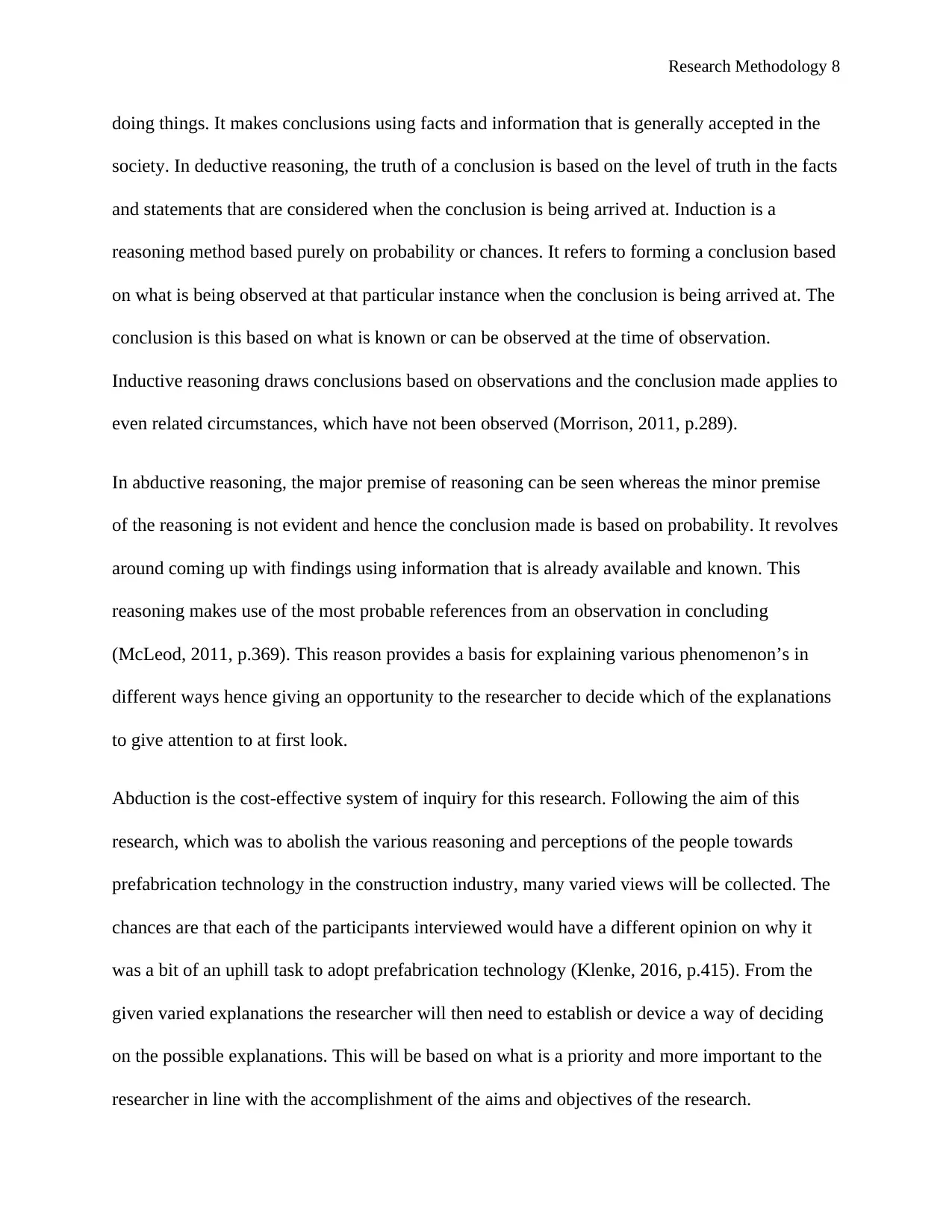
Research Methodology 8
doing things. It makes conclusions using facts and information that is generally accepted in the
society. In deductive reasoning, the truth of a conclusion is based on the level of truth in the facts
and statements that are considered when the conclusion is being arrived at. Induction is a
reasoning method based purely on probability or chances. It refers to forming a conclusion based
on what is being observed at that particular instance when the conclusion is being arrived at. The
conclusion is this based on what is known or can be observed at the time of observation.
Inductive reasoning draws conclusions based on observations and the conclusion made applies to
even related circumstances, which have not been observed (Morrison, 2011, p.289).
In abductive reasoning, the major premise of reasoning can be seen whereas the minor premise
of the reasoning is not evident and hence the conclusion made is based on probability. It revolves
around coming up with findings using information that is already available and known. This
reasoning makes use of the most probable references from an observation in concluding
(McLeod, 2011, p.369). This reason provides a basis for explaining various phenomenon’s in
different ways hence giving an opportunity to the researcher to decide which of the explanations
to give attention to at first look.
Abduction is the cost-effective system of inquiry for this research. Following the aim of this
research, which was to abolish the various reasoning and perceptions of the people towards
prefabrication technology in the construction industry, many varied views will be collected. The
chances are that each of the participants interviewed would have a different opinion on why it
was a bit of an uphill task to adopt prefabrication technology (Klenke, 2016, p.415). From the
given varied explanations the researcher will then need to establish or device a way of deciding
on the possible explanations. This will be based on what is a priority and more important to the
researcher in line with the accomplishment of the aims and objectives of the research.
doing things. It makes conclusions using facts and information that is generally accepted in the
society. In deductive reasoning, the truth of a conclusion is based on the level of truth in the facts
and statements that are considered when the conclusion is being arrived at. Induction is a
reasoning method based purely on probability or chances. It refers to forming a conclusion based
on what is being observed at that particular instance when the conclusion is being arrived at. The
conclusion is this based on what is known or can be observed at the time of observation.
Inductive reasoning draws conclusions based on observations and the conclusion made applies to
even related circumstances, which have not been observed (Morrison, 2011, p.289).
In abductive reasoning, the major premise of reasoning can be seen whereas the minor premise
of the reasoning is not evident and hence the conclusion made is based on probability. It revolves
around coming up with findings using information that is already available and known. This
reasoning makes use of the most probable references from an observation in concluding
(McLeod, 2011, p.369). This reason provides a basis for explaining various phenomenon’s in
different ways hence giving an opportunity to the researcher to decide which of the explanations
to give attention to at first look.
Abduction is the cost-effective system of inquiry for this research. Following the aim of this
research, which was to abolish the various reasoning and perceptions of the people towards
prefabrication technology in the construction industry, many varied views will be collected. The
chances are that each of the participants interviewed would have a different opinion on why it
was a bit of an uphill task to adopt prefabrication technology (Klenke, 2016, p.415). From the
given varied explanations the researcher will then need to establish or device a way of deciding
on the possible explanations. This will be based on what is a priority and more important to the
researcher in line with the accomplishment of the aims and objectives of the research.
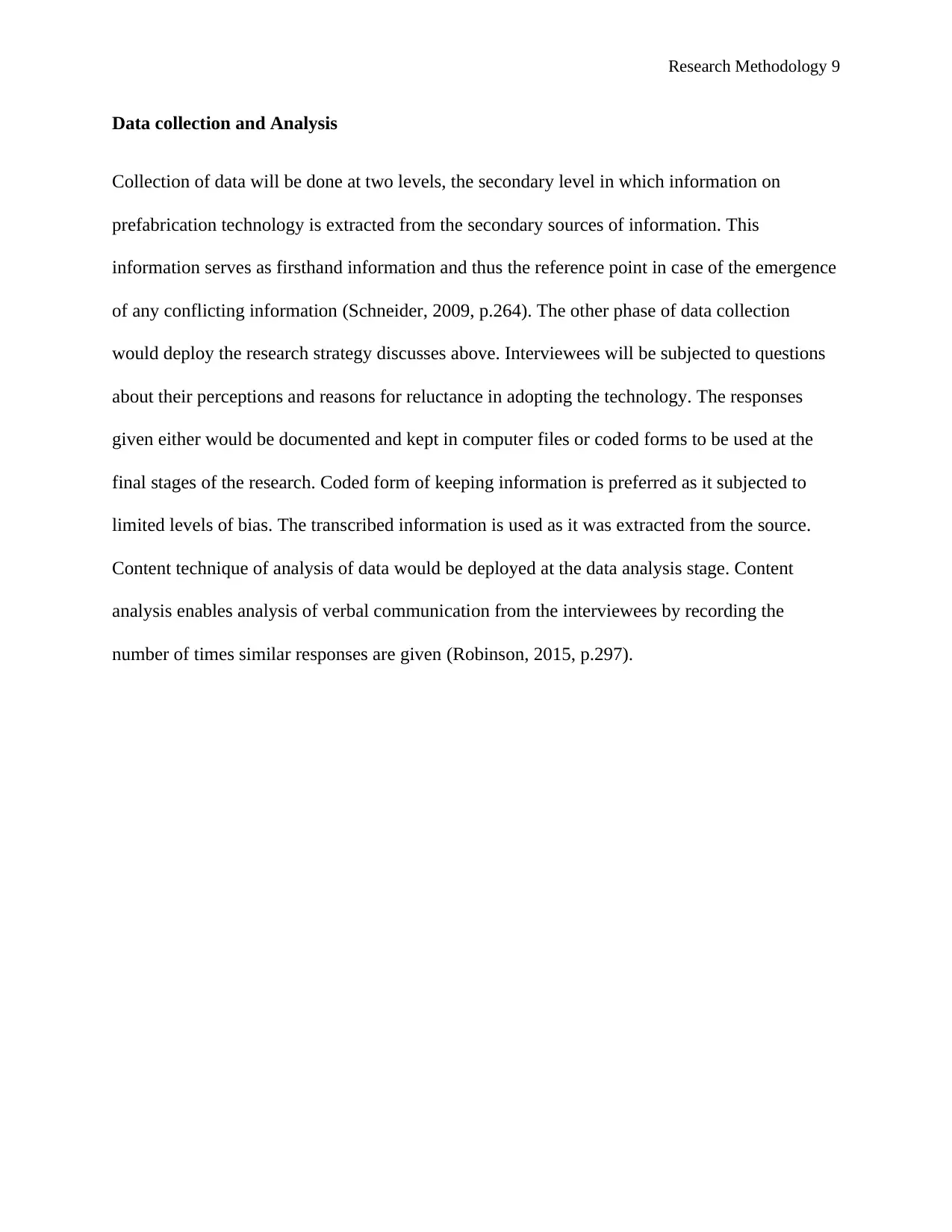
Research Methodology 9
Data collection and Analysis
Collection of data will be done at two levels, the secondary level in which information on
prefabrication technology is extracted from the secondary sources of information. This
information serves as firsthand information and thus the reference point in case of the emergence
of any conflicting information (Schneider, 2009, p.264). The other phase of data collection
would deploy the research strategy discusses above. Interviewees will be subjected to questions
about their perceptions and reasons for reluctance in adopting the technology. The responses
given either would be documented and kept in computer files or coded forms to be used at the
final stages of the research. Coded form of keeping information is preferred as it subjected to
limited levels of bias. The transcribed information is used as it was extracted from the source.
Content technique of analysis of data would be deployed at the data analysis stage. Content
analysis enables analysis of verbal communication from the interviewees by recording the
number of times similar responses are given (Robinson, 2015, p.297).
Data collection and Analysis
Collection of data will be done at two levels, the secondary level in which information on
prefabrication technology is extracted from the secondary sources of information. This
information serves as firsthand information and thus the reference point in case of the emergence
of any conflicting information (Schneider, 2009, p.264). The other phase of data collection
would deploy the research strategy discusses above. Interviewees will be subjected to questions
about their perceptions and reasons for reluctance in adopting the technology. The responses
given either would be documented and kept in computer files or coded forms to be used at the
final stages of the research. Coded form of keeping information is preferred as it subjected to
limited levels of bias. The transcribed information is used as it was extracted from the source.
Content technique of analysis of data would be deployed at the data analysis stage. Content
analysis enables analysis of verbal communication from the interviewees by recording the
number of times similar responses are given (Robinson, 2015, p.297).
⊘ This is a preview!⊘
Do you want full access?
Subscribe today to unlock all pages.

Trusted by 1+ million students worldwide
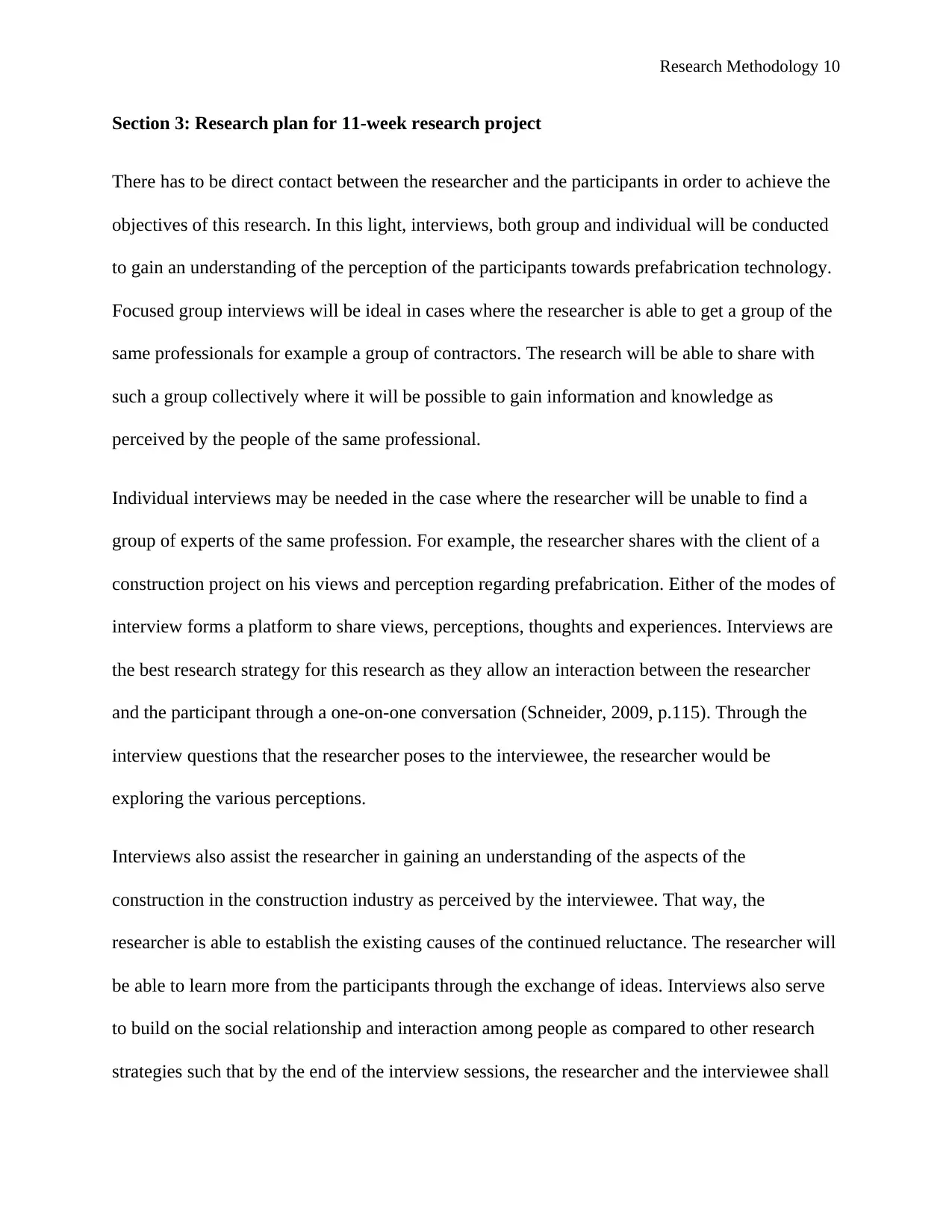
Research Methodology 10
Section 3: Research plan for 11-week research project
There has to be direct contact between the researcher and the participants in order to achieve the
objectives of this research. In this light, interviews, both group and individual will be conducted
to gain an understanding of the perception of the participants towards prefabrication technology.
Focused group interviews will be ideal in cases where the researcher is able to get a group of the
same professionals for example a group of contractors. The research will be able to share with
such a group collectively where it will be possible to gain information and knowledge as
perceived by the people of the same professional.
Individual interviews may be needed in the case where the researcher will be unable to find a
group of experts of the same profession. For example, the researcher shares with the client of a
construction project on his views and perception regarding prefabrication. Either of the modes of
interview forms a platform to share views, perceptions, thoughts and experiences. Interviews are
the best research strategy for this research as they allow an interaction between the researcher
and the participant through a one-on-one conversation (Schneider, 2009, p.115). Through the
interview questions that the researcher poses to the interviewee, the researcher would be
exploring the various perceptions.
Interviews also assist the researcher in gaining an understanding of the aspects of the
construction in the construction industry as perceived by the interviewee. That way, the
researcher is able to establish the existing causes of the continued reluctance. The researcher will
be able to learn more from the participants through the exchange of ideas. Interviews also serve
to build on the social relationship and interaction among people as compared to other research
strategies such that by the end of the interview sessions, the researcher and the interviewee shall
Section 3: Research plan for 11-week research project
There has to be direct contact between the researcher and the participants in order to achieve the
objectives of this research. In this light, interviews, both group and individual will be conducted
to gain an understanding of the perception of the participants towards prefabrication technology.
Focused group interviews will be ideal in cases where the researcher is able to get a group of the
same professionals for example a group of contractors. The research will be able to share with
such a group collectively where it will be possible to gain information and knowledge as
perceived by the people of the same professional.
Individual interviews may be needed in the case where the researcher will be unable to find a
group of experts of the same profession. For example, the researcher shares with the client of a
construction project on his views and perception regarding prefabrication. Either of the modes of
interview forms a platform to share views, perceptions, thoughts and experiences. Interviews are
the best research strategy for this research as they allow an interaction between the researcher
and the participant through a one-on-one conversation (Schneider, 2009, p.115). Through the
interview questions that the researcher poses to the interviewee, the researcher would be
exploring the various perceptions.
Interviews also assist the researcher in gaining an understanding of the aspects of the
construction in the construction industry as perceived by the interviewee. That way, the
researcher is able to establish the existing causes of the continued reluctance. The researcher will
be able to learn more from the participants through the exchange of ideas. Interviews also serve
to build on the social relationship and interaction among people as compared to other research
strategies such that by the end of the interview sessions, the researcher and the interviewee shall
Paraphrase This Document
Need a fresh take? Get an instant paraphrase of this document with our AI Paraphraser
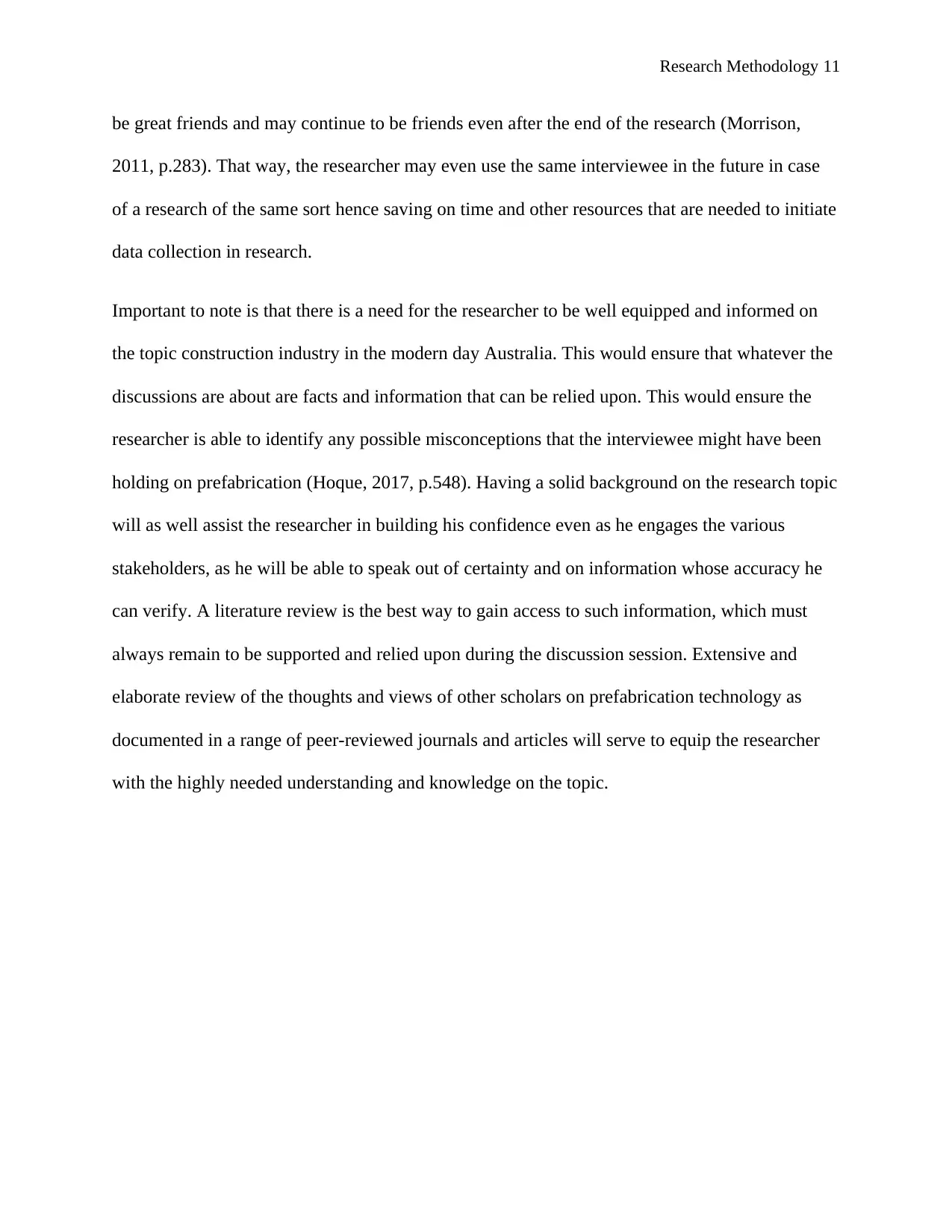
Research Methodology 11
be great friends and may continue to be friends even after the end of the research (Morrison,
2011, p.283). That way, the researcher may even use the same interviewee in the future in case
of a research of the same sort hence saving on time and other resources that are needed to initiate
data collection in research.
Important to note is that there is a need for the researcher to be well equipped and informed on
the topic construction industry in the modern day Australia. This would ensure that whatever the
discussions are about are facts and information that can be relied upon. This would ensure the
researcher is able to identify any possible misconceptions that the interviewee might have been
holding on prefabrication (Hoque, 2017, p.548). Having a solid background on the research topic
will as well assist the researcher in building his confidence even as he engages the various
stakeholders, as he will be able to speak out of certainty and on information whose accuracy he
can verify. A literature review is the best way to gain access to such information, which must
always remain to be supported and relied upon during the discussion session. Extensive and
elaborate review of the thoughts and views of other scholars on prefabrication technology as
documented in a range of peer-reviewed journals and articles will serve to equip the researcher
with the highly needed understanding and knowledge on the topic.
be great friends and may continue to be friends even after the end of the research (Morrison,
2011, p.283). That way, the researcher may even use the same interviewee in the future in case
of a research of the same sort hence saving on time and other resources that are needed to initiate
data collection in research.
Important to note is that there is a need for the researcher to be well equipped and informed on
the topic construction industry in the modern day Australia. This would ensure that whatever the
discussions are about are facts and information that can be relied upon. This would ensure the
researcher is able to identify any possible misconceptions that the interviewee might have been
holding on prefabrication (Hoque, 2017, p.548). Having a solid background on the research topic
will as well assist the researcher in building his confidence even as he engages the various
stakeholders, as he will be able to speak out of certainty and on information whose accuracy he
can verify. A literature review is the best way to gain access to such information, which must
always remain to be supported and relied upon during the discussion session. Extensive and
elaborate review of the thoughts and views of other scholars on prefabrication technology as
documented in a range of peer-reviewed journals and articles will serve to equip the researcher
with the highly needed understanding and knowledge on the topic.
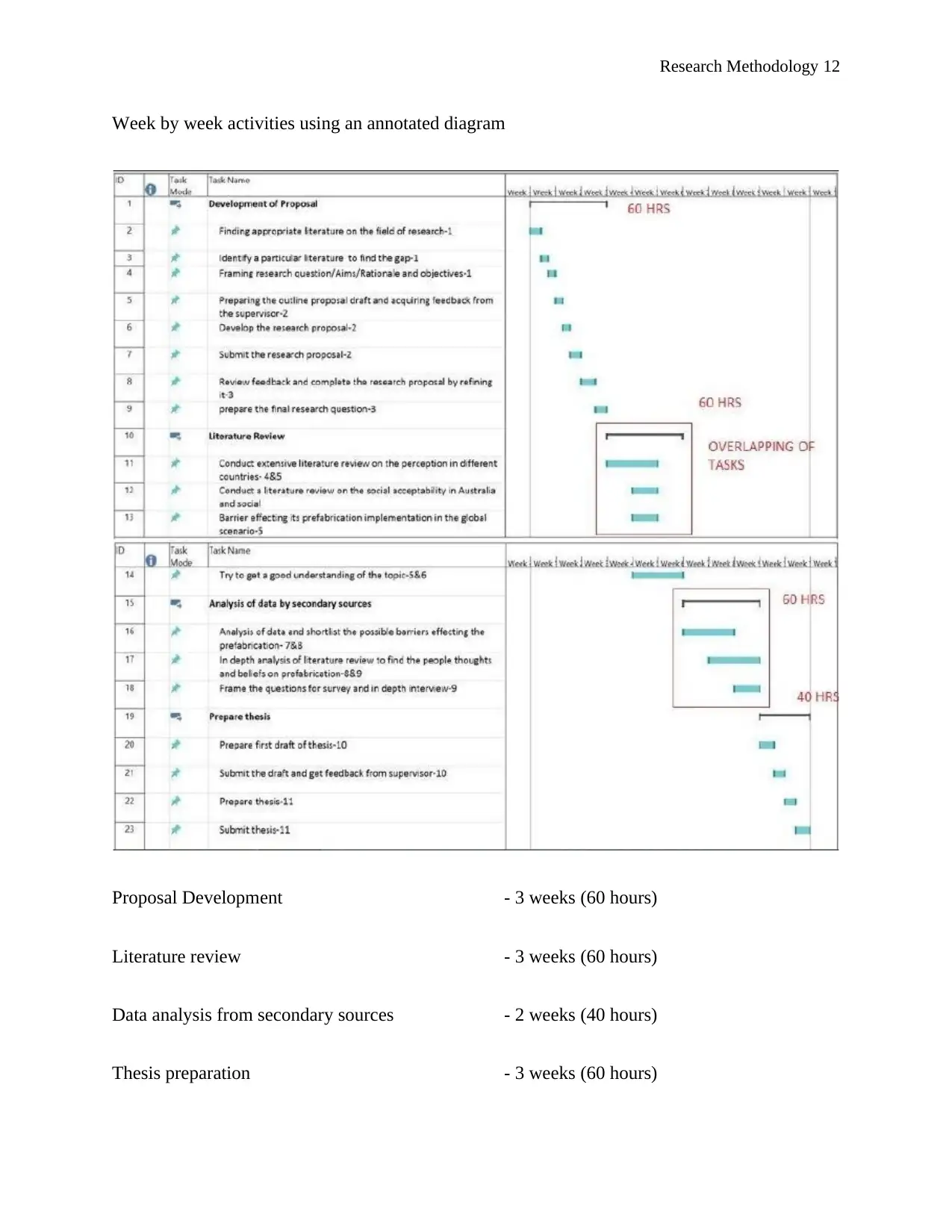
Research Methodology 12
Week by week activities using an annotated diagram
Proposal Development - 3 weeks (60 hours)
Literature review - 3 weeks (60 hours)
Data analysis from secondary sources - 2 weeks (40 hours)
Thesis preparation - 3 weeks (60 hours)
Week by week activities using an annotated diagram
Proposal Development - 3 weeks (60 hours)
Literature review - 3 weeks (60 hours)
Data analysis from secondary sources - 2 weeks (40 hours)
Thesis preparation - 3 weeks (60 hours)
⊘ This is a preview!⊘
Do you want full access?
Subscribe today to unlock all pages.

Trusted by 1+ million students worldwide
1 out of 14
Your All-in-One AI-Powered Toolkit for Academic Success.
+13062052269
info@desklib.com
Available 24*7 on WhatsApp / Email
![[object Object]](/_next/static/media/star-bottom.7253800d.svg)
Unlock your academic potential
Copyright © 2020–2025 A2Z Services. All Rights Reserved. Developed and managed by ZUCOL.
